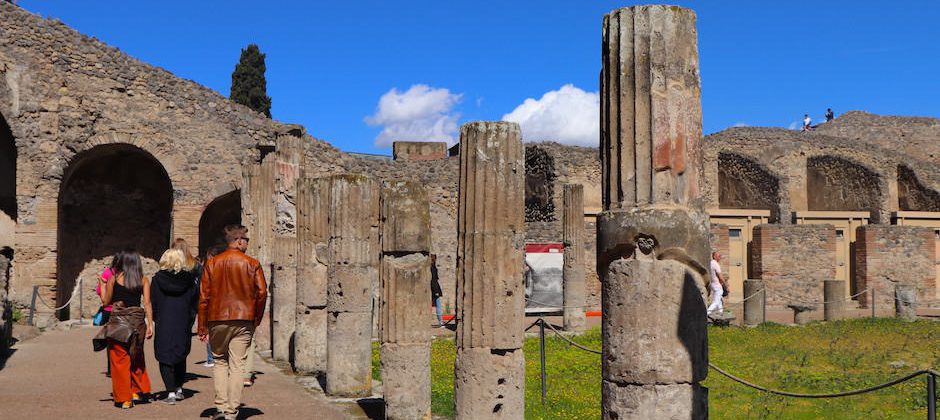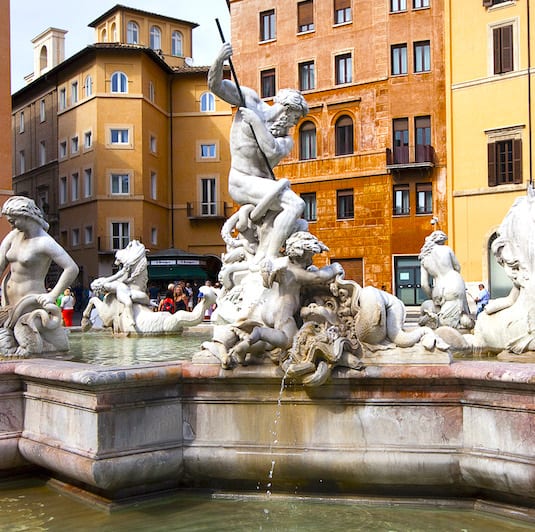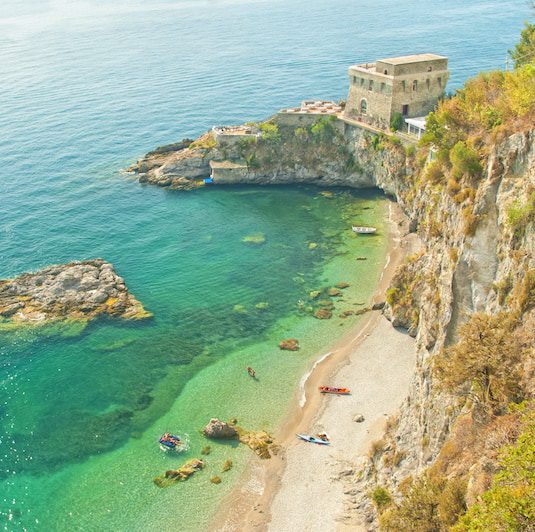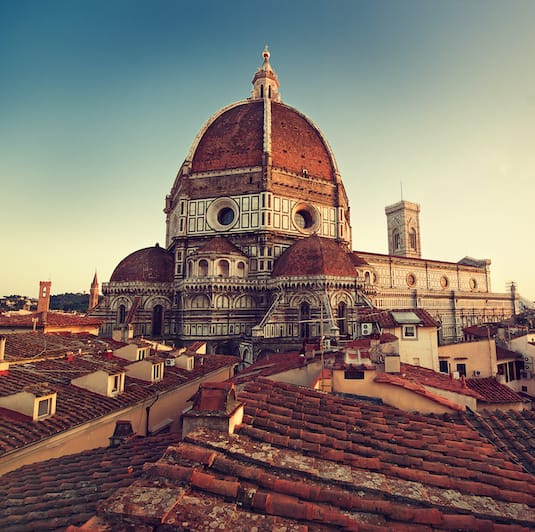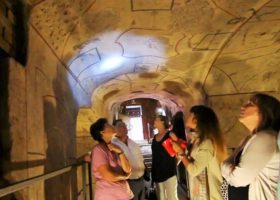Have you ever had the chance to walk around an ancient Roman city with a tragic story? You can at Pompeii! It’s one of the largest and best-preserved archeological sites on Earth, with a huge amount to see and millions of annual visitors. If you’re not sure where to start, don’t worry. In this guide, we’ll explain everything you need to know about how to visit Pompeii.
Pro Tip: Planning to visit Pompeii? Bookmark this post in your browser so you can easily find it when you’re traveling. See our guide to Pompeii and Amalfi Coast for more planning resources and our top-rated Pompeii day trip from Rome and other Pompeii tours for a memorable and easy trip.
How To Visit Pompeii: What We’ll Cover
Pompeii was a booming port city in the ancient Roman Empire. But all that changed on August 24th, A.D. 79, when the Mt. Vesuvius volcano erupted, sending a 10-mile high mushroom cloud of ash and pumice into the stratosphere. Those who were not killed by the missiles of pumice raining down or the lava were wiped out by the toxic gases.
This disastrous day for the Romans has given us an intimate look into what life was like in an ancient Roman city. The volcanic ash and mud from the eruption encased and preserved the city’s artifacts and some of the people’s bodies, clothes, and even places of business.
Over 2.5 million people visit the archeological site of Pompeii annually, taking a journey back in time. In this guide on how to visit Pompeii, we’ll cover:
- Opening hours and tickets
- How to get to Pompeii
- What to see at Pompeii
- Guided tour options
- Where to eat nearby
Not ready to book a tour? See if a Pompeii day trip from Rome is worth it.
Pompeii Opening Hours and Tickets
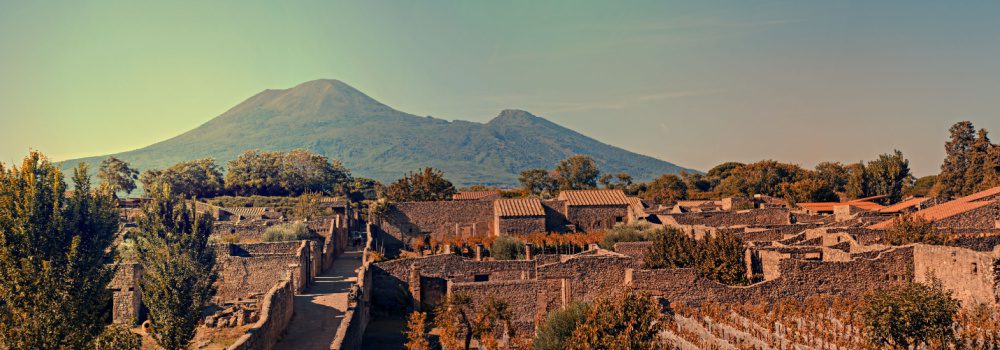
Pompeii is open to visitors every day of the week (with seasonal visiting hours) except on December 25, May 1, and January 1, when it is closed—unless otherwise communicated on the website.
You can buy your tickets to visit the Pompeii Archaeological Park directly at the entrance gates. There are three entrances to the archeological park: Porta Marina, Piazza Anfiteatro, and Piazza Esedra.
You will most likely be entering through the Porta Marina, which is the entrance next to the train station and main parking area. It is also the main ticket desk, so you can buy your ticket here and begin your adventure.
Opening Hours:
- From April 1 to October 31: Open 9 am to 7 pm, last entrance at 5:30 pm.
- From November 1 to March 31: Open 9 am to 5 pm, last entrance at 3:30 pm.
Tickets:
- Adult full ticket: €19
- Reduced ticket: €2
- Free under 18 years old
Popular Tours from Rome
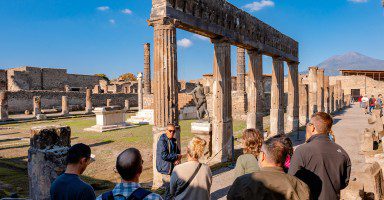
Best Seller
Unforgettable Rome Day Trip to Pompeii and Sorrento
Making a day trip from Rome to Pompeii and the Amalfi Coast can be daunting, with long travel times, complex routes, and tricky logistics to manage. Our full-day tour eliminates the stress, offering comfortbale transport straight to Pompeii. With an archaeologist guide, explore the ancient ruins without the hassle. Then, unwind with free time in Sorrento’s coastal charm. Led by a local guide and small group, this trip makes experiencing Italy’s highlights easy and enjoyable—all in one day.
See prices and more info
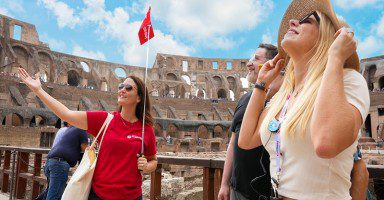
Best Seller
Rome in a Day Tour with Colosseum & Vatican Museums
Seeing the best of Rome in a single day might seem like a big undertaking, but our expertly designed tour makes it effortless with skip-the-line tickets, included transportation, and engaging guides to lead the way. In just 7 hours, you’ll visit renowned sites like the Sistine Chapel, Colosseum, Trevi Fountain, and Pantheon. With fascinating stories at every stop, you can skip the stress and immerse yourself in the vibrant heritage and culture of Rome all in one remarkable day.
See prices and more info
Not ready to book a tour? Find out if a Pompeii day trip from Rome is worth it.
How To Get To Pompeii
Most people who visit Pompeii come by train from Naples. The good thing is that the train station where you need to get off is right in front of the entrance to the archeological park. It’s a quick walk to the entrance, and you can’t miss it.
See the details below to get to Pompeii by train from Rome and the Amalfi Coast and directions for those who have rented a car.
From Rome
By Train:
The high-speed train from Rome to Naples runs every 20 minutes. You can take the train from Roma Termini station to Napoli Centrale in just over an hour. Book on Trenitalia or through Italo. They are two competing train companies. I prefer Italo.
From Napoli Centrale, you can switch to the local train to Pompeii. The local train called the Circumvesuviana, is located down the corridor in what is technically Napoli Garibaldi Station.
Take the train towards Sorrento, and you will arrive at the Pompei Scavi – Villa Dei Misteri station after about 20 minutes. The station is a matter of feet from the entrance to the archaeological area.
If you choose to take the train to Pompeii on your own but are still looking for a guided tour, check out our Skip the Line Pompeii Ruins Tour with Villa of Mysteries.
The Italian government has just introduced a direct train from Rome to Pompeii that makes thing much easier. At the moment, it runs once a month and is already sold out till the end of 2023. There are plans to expand this service in 2024, so watch this space.
By Car:
If you’ve rented a car, it’s quite easy. Get on the Grande Raccordo Anulare (GRA) and head onto the A1 highway to Naples. Once you get close to Naples you change to the Motorway A3 Napoli-Salerno (exit Pompeii ovest). Or just add the destination to your GPS.
From the Amalfi Coast
By Train:
Sorrento is the only town with a train station. If you’re not in Sorrento, you’ll need to make your way there, jump on the train headed in the direction of Napoli Centrale, and get off at Pompei Scavi – Villa Dei Misteri.
By Car:
For the adventurous souls who rent a car, get to the Motorway A3 Napoli-Salerno (exit Pompeii ovest). Or just add it to your GPS
What To See At Pompeii
There’s a lot to see at Pompeii, so when you visit, make sure you don’t miss any of these sites. For more details about the items on this list, see our guide on the top things to see at Pompeii.
1. The Amphitheater
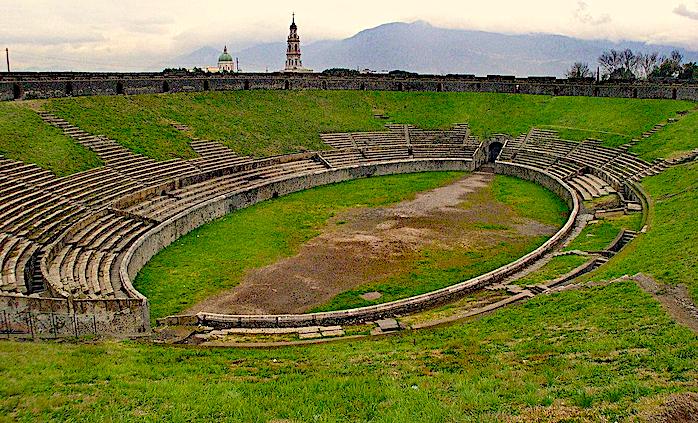
The oldest known building of its kind, the amphitheater of Pompeii held 20,000 people and was host to gladiator games and large spectacles just like the Colosseum in Rome. The stone structure is a great example of the large functioning society in the ancient town. Pink Floyd had a concert here back in 1972!
2. The Forum of Pompeii
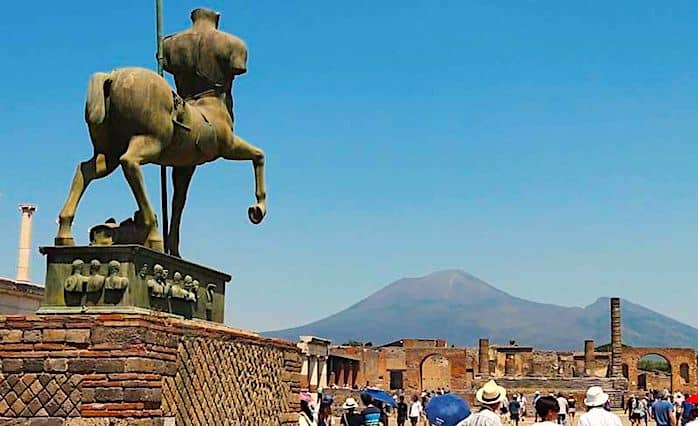
Just like the Roman Forum, the Forum of Pompeii was the center of activity and commerce in the town. It’s where you’ll find the city’s major temples: the Temples of Venus, Apollo, and Jupiter. You will also find the grand Forum Baths there.
3. Pompeii’s Forum Baths
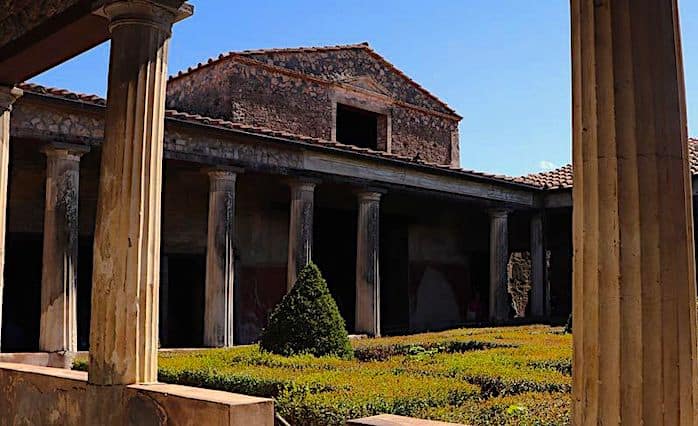
One common misconception is that all ancient people were dirty and rarely bathed. In many cases this is true, but the ancient Romans were not this way.
Though only the very rich could afford private baths, the public Roman baths in the Forum were for people of all social statuses. The area was divided into men’s and women’s sections.
It included the three rooms of the ancient Roman Bath, the tepidarium (warm bath), caldarium (hot bath), and frigidarium (cold bath). Classically, one would bathe in each one in that order.
4. Pompeii’s Brothel

The world’s oldest profession had its place in ancient Rome, and the most evident example of this in Pompeii can be found in this building. In Latin, they were called lupanar and the prostitutes were slaves brought in to cement Pompeii as a city of sin.
Consisting of many small rooms with beds, the building is also covered with fascinating explicit images of what took place at the brothel. We also know the names of many of the women who worked here due to graffiti left behind by happy customers.
5. The Palaestra
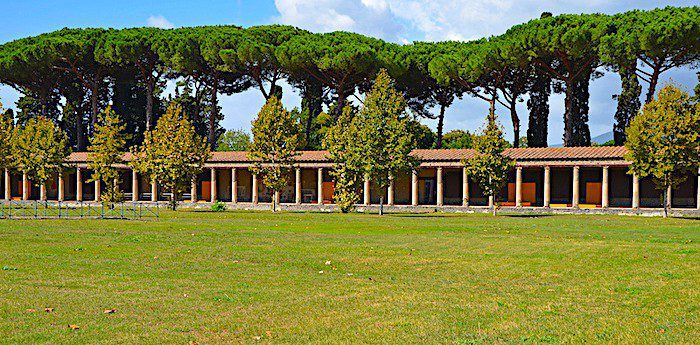
If you’re from Philadelphia, you will recognize the word palaestra from The Palestra on the campus of the University of Pennsylvania. Palaestra is the Latin word for “gym” and was similar to our modern-day version consisting of areas for training and even a swimming pool.
6. The Large Theater
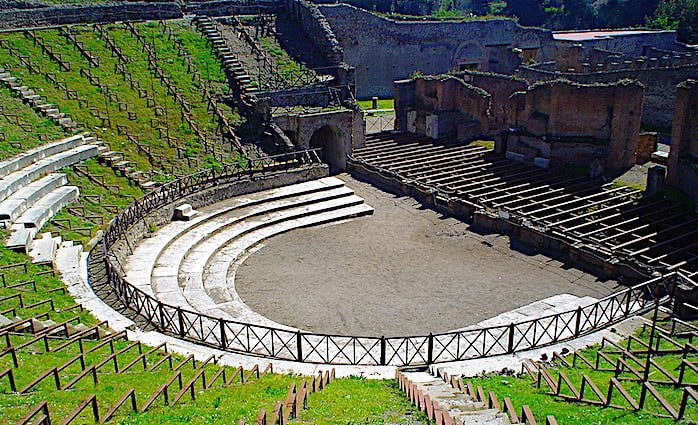
The Amphitheater was not the only center for entertainment in Pompeii. The large theatre held about 5,000 people and Greek tragedies were usually performed here.
Popular Tours from Rome

Best Seller
Unforgettable Rome Day Trip to Pompeii and Sorrento
Making a day trip from Rome to Pompeii and the Amalfi Coast can be daunting, with long travel times, complex routes, and tricky logistics to manage. Our full-day tour eliminates the stress, offering comfortbale transport straight to Pompeii. With an archaeologist guide, explore the ancient ruins without the hassle. Then, unwind with free time in Sorrento’s coastal charm. Led by a local guide and small group, this trip makes experiencing Italy’s highlights easy and enjoyable—all in one day.
See prices and more info

Best Seller
Rome in a Day Tour with Colosseum & Vatican Museums
Seeing the best of Rome in a single day might seem like a big undertaking, but our expertly designed tour makes it effortless with skip-the-line tickets, included transportation, and engaging guides to lead the way. In just 7 hours, you’ll visit renowned sites like the Sistine Chapel, Colosseum, Trevi Fountain, and Pantheon. With fascinating stories at every stop, you can skip the stress and immerse yourself in the vibrant heritage and culture of Rome all in one remarkable day.
See prices and more info
Not ready to book a tour? Find out if a Pompeii day trip from Rome is worth it.
7. Gladiator Barracks
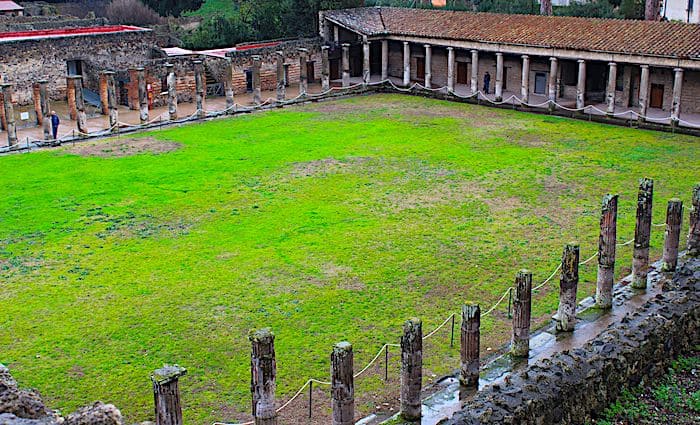
As the name implies, the gladiator barracks were where the gladiators trained for their life-and-death matches at the Amphitheater.
8. The Preserved Plaster Casts
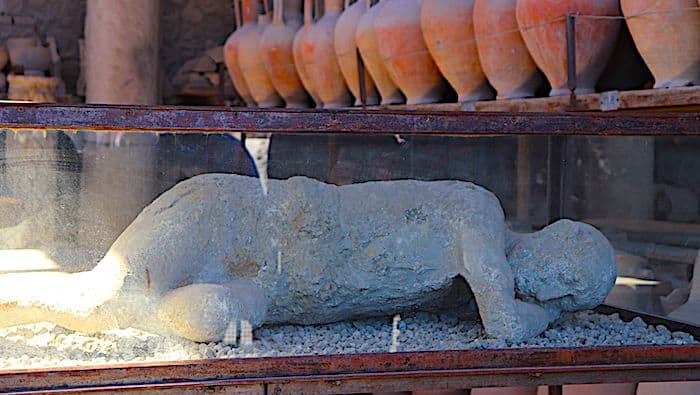
A rotating exhibit around Pompeii, these casts were created during the excavations of the ruins. You’ll see people in the positions they were in when they were preserved in ash on that fateful day and the display includes dogs, pregnant women, and children.
If you want to experience more of this history after your time in Pompeii, you can climb Mount Vesuvius volcano and see the source of the tragedy. Or, head to Herculaneum to see more very well-preserved antiquities.
9. Villa dei Misteri
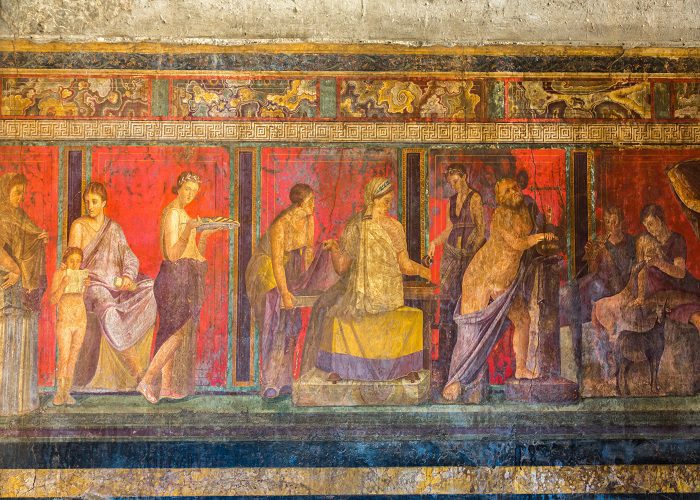
The Villa dei Misteri (Villa of Mysteries) is a bit of a hike from the other sites and is actually outside the ancient walls of Pompeii, but the frescoes are definitely worth the walk.
The name comes from a fresco, which is surprisingly still intact and covers three whole walls. It shows the initiation of a young girl into the mystery cult of Bacchus or Dionysus.
10. Temple of Apollo
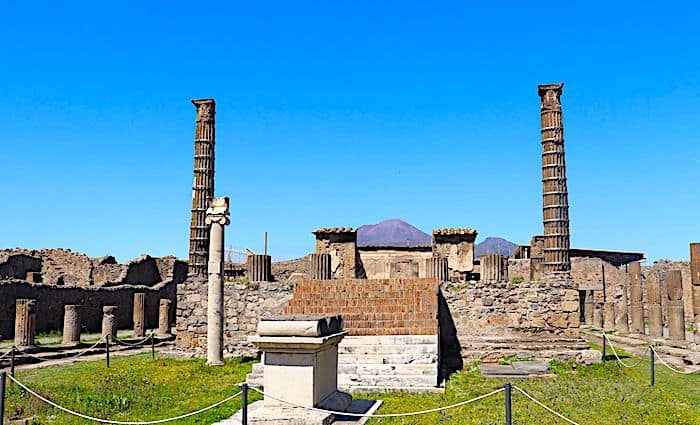
This is one of Pompeii’s oldest temples and attests to the God Apollo’s strong presence in the Campania region during that time. Excavations indicate that a pre-existing temple was on this site as early as the 6th century BC! Its importance is also indicated by its proximity to the Forum.
11. House of Vettii
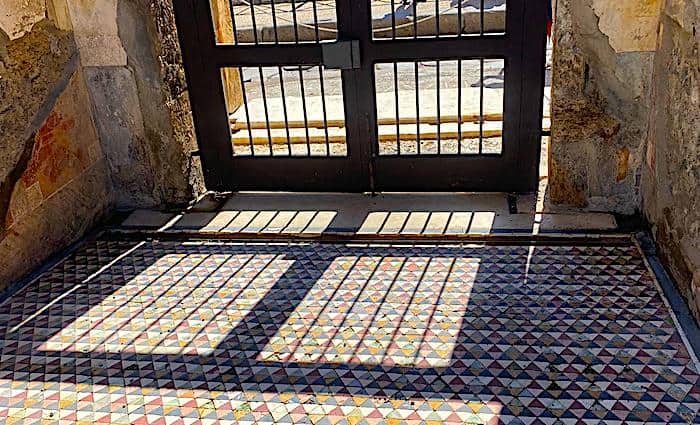
The name comes from two brothers (Aulus Vettius Conviva and Aulus Vettius Restitutus) who were slaves that received their freedom. You can see where the gardens and lararium were as well as the general plan of the house.
After reopening in 2016 after 12 years of restoration, the frescos you see here are some of the greatest examples of ancient Roman artwork. There is also a famous fresco of the fertility god Priapus that gained fame over time. When you see it, you’ll understand.
12. House of the Tragic Poet
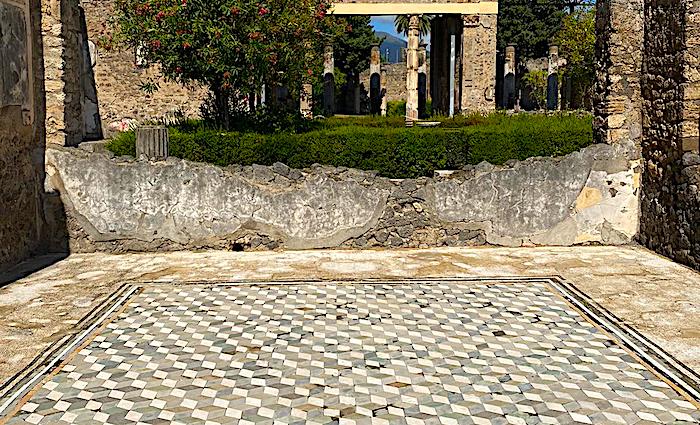
Why is it called the House of the Poet? The name is attributed to a mosaic of a poet and actor preparing for a play. There are many other fine mosaics located here, like the famous Cave Canem and Ariadne being abandoned by Theseus.
13. House of the Faun
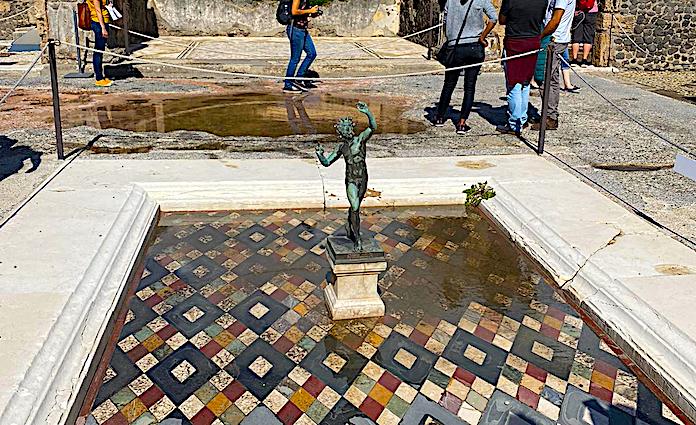
The word “house” is actually a misnomer since it covers an entire city block at 32,000 square feet (3,000 square meters). The owner had so much money he actually had a mosaic built into the street in front of his house with the Latin word HAVE which means: “greetings!”
14. Cave Canem Mosaic
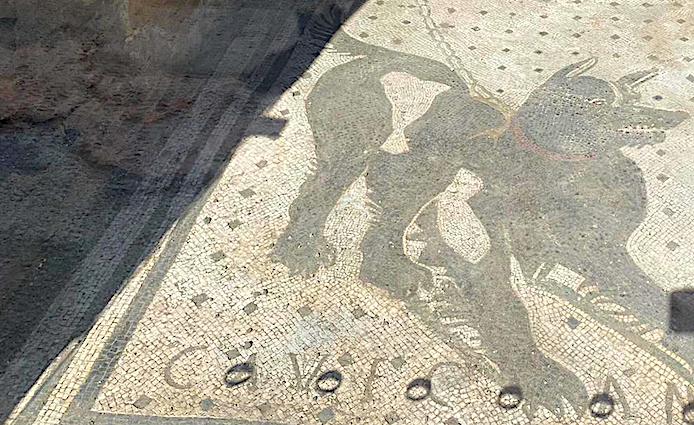
At the entrance to the House of the Tragic Poet (see above) there is a mosaic of a dog, which served as a doormat, with letters below it that read Cave Canem in Latin, which translates as “beware of the dog”. This just goes to show that we haven’t changed much after 2,000 years.
15. Mt. Vesuvius
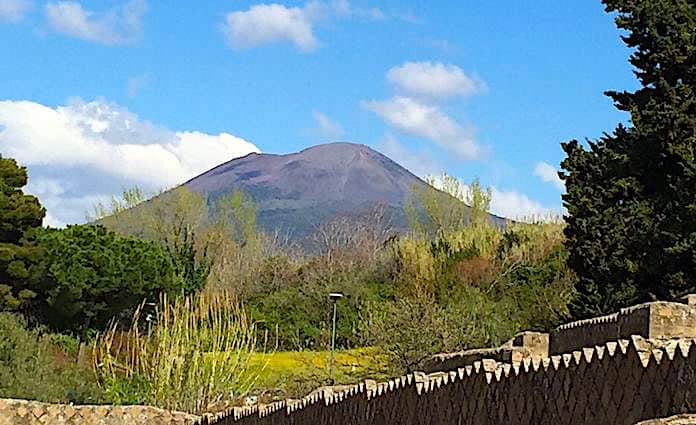
The most famous and still active volcano of all time is not situated in the architectural complex of Pompeii and is not even in the city itself, but I would be remiss not to mention it. The last eruption was in 1944, but don’t worry—the experts say we should have some time before the next big one happens.
To complete your Pompeii journey, you should definitely go the short drive away and check out the volcano that made Pompeii famous to us today!
Not ready to book a tour? Check out our Pompeii Guide for more info.
Pompeii Tour Options
We are a tour company, so we always recommend giving tours, not only to keep our lights on but also because we believe it is by far the best way to see a site. You can certainly DIY Pompeii, but you will get much more out of your time with a local, expert guide.
Here are some best-selling guided tour options, some of which include roundtrip transportation from Rome, a stop in Sorrento, or a guided trek up Mt. Vesuvius. All offer skip-the-line access and a knowledgeable local guide.
Skip the Line Pompeii Ruins Tour with Villa of Mysteries
This is a 2-hour, small-group tour for people who are already in Pompeii or have decided to sort out their own transportation. There’s a lot to see in Pompeii and almost none of it is marked since it’s a preserved historical site. Let our expert local guide explain all the best sites as they share crazy anecdotes and stories from the ancient world.
See tour itinerary, price, and description
Unforgettable Rome Day Trip to Pompeii and Sorrento
This is a small-group tour with round-trip transportation from Rome. It includes a tour leader who will be with you for the day and an archaeological guide who will lead you through the ruins of Pompeii. After visiting the ruins with our expert guide, you’ll then travel on to beautiful Sorrento where you’ll have some free time for shopping and a meal. A private tour is also available if preferred.
See tour itinerary, price, and description
Private Pompeii and Mt. Vesuvius Day Trip: From Amalfi Coast
This is a private tour for those who are staying in the Amalfi Coast area and don’t want to worry about transportation. We also set up local, expert guides for you in Pompeii and Mt. Vesuvius—trek all the way to the top and peer into the crater!
See tour itinerary, price, and description
Not ready to book a tour? Find out if a Pompeii day trip from Rome is worth it.
Places To Eat Nearby
Options are fairly limited nearby as far as eating and refreshments go. However, if you’re famished or in need of a cup of coffee, here’s where to go:
Autogrill Pompeii: € | Refreshments—Calling it a cafeteria is a stretch, but it is the only place inside the archeological park to get some refreshments. It’s located behind the Temple of Jupiter.
Bar Sgambati: €€ | Quick Snack—This is the Bar/ Restaurant/ Pizzeria right next to the train station where you get off to visit Pompeii. The food and prices are average, but this is your best bet to get something to eat in the area before or after your trip to the archeological site.
Here’s Where To Stay in Italy’s Most Popular Destinations
Rome, Florence, Venice, Amalfi Coast, and Capri

